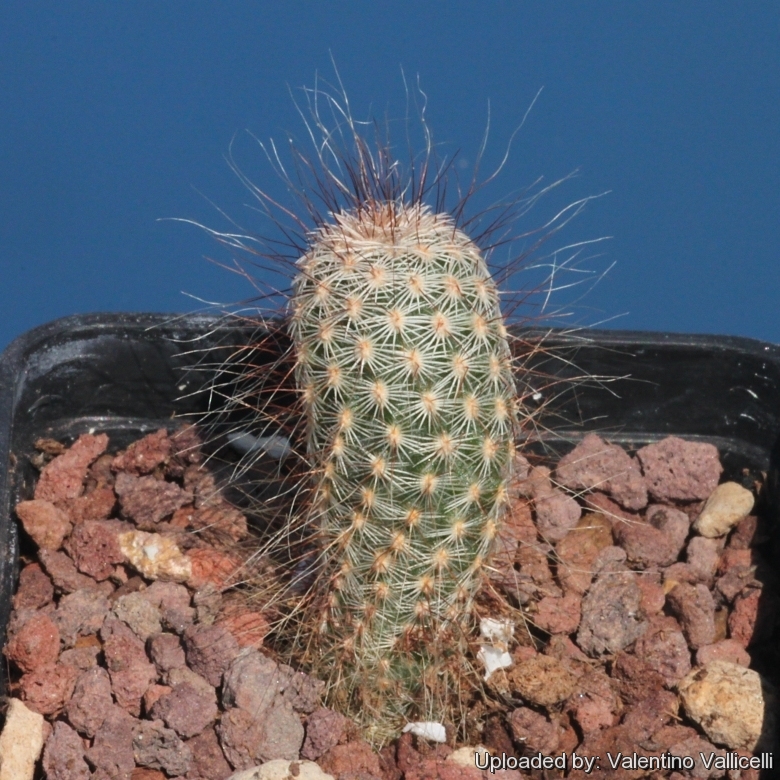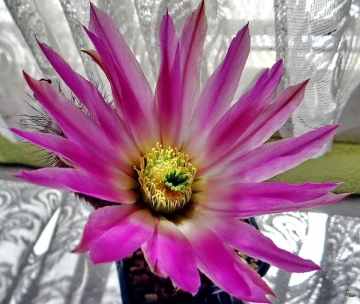
Echinocereus primolanatus Photo by: Valentino Vallicelli
Origin and Habitat: Echinocereus primolanatusSN|32695]]SN|32695]] is endemic to the state of Coahuila in Mexico, occurring in the Edge of the Sierra de la Paila, between Estación Marte and Hipólito and El Papalote, and from the Cuatro Ciénegas Region and Sierra de los Alamitos. Extent of occurrence less than 10,000 km².
Altitude range: From around 1,200 to 1,600 metres above sea level.
Habitat and Ecology: This species grows in fine silty soil probably over limestone on exposed slopes presumably in xerophytic shrubland (Matorrales micrófilo y rosetófilo). Nothing is known about the he population and trends, or about any threats to this species.
Synonyms:
Common Names include:
ENGLISH: Bristles hedgehog cactus
SPANISH (Español): Alicoche peludo
Description: Echinocereus primolanatusSN|32695]]SN|32695]] is a very peculiar species usually solitary. The young plants initially with the stem clothed with very fine and thin hairs. The flowers are up to 9 cm broad, sensationally large for a so small plant, dark pink with purple glimmer and very showy, the tube is densely covered by white felt,scales and bristles. The flowers can last for 4–5 days.
Derivation of specific name. Lat. 'primus', the first; and Lat. 'lanatus', woolly; for the striking white wolly central spines present only on young stems.
Roots: Sometimes large.
Stems: Globose to cylindrical, green, 4-12 cm long, 2.5-5.5 cm in diameter obscured by spines.
Ribs: 16-26, low, slightly tuberculate.
Central spines: 1-3, hairlike, very fine and thin, present only on young stems, brownish, 7 to 15 mm long.
Radial spines: 20-28, in two comblike rows, dirty white or pink-white, 2-4 mm long.
Flowers: Borne near the stem tips from very woolly buds, broadly funnelform, bright pink,
5.5-9 cm long, 5-9 cm in diameter. Pericarpel and tube38-40 mm long, green but dark reddish-brown towards apex, densely clothed in areole with long wool and white to dark brown bristle spines. Nectar-chamber 1 deep, 3 mm in diameter, filled by style base. Perianth-segments to 60 x ll-14mm, rounded to gradually acuminate at apex, outermost intergrading with tube scales, linear, to 27 x 1.5mm, bearing an areole with bristle-spines and wool below apex, outer segments with brownish green midrib, inner segments pale pinkish magenta with a narrow darker midstripe, nearly white towards base. Stamens 10 mm, filaments pale greenish, white above, anthers golden yellow. Style 20 mm long, white, stigma-lobes 8-15, dark green.
Fruits: 13 mm long, 7-8 mm thick, ovoid, nearly dry, splitting longitudinally, with dense wool and spines.
Seeds: 1.3x 1.3 mm, testa with elongated tubercles.
Bibliography: Major references and further lectures
1) David R Hunt; Nigel P Taylor; Graham Charles; International Cactaceae Systematics Group. "The New Cactus Lexicon" dh books, 2006
2) Edward Anderson “The Cactus family” Timber Press, Incorporated, 2001
3) Fitz Maurice, B, Fitz Maurice, W.A., Hernández, H.M. & Sotomayor, M. 2013. Echinocereus primolanatus. The IUCN Red List of Threatened Species 2013: e.T152253A615067. http://dx.doi.org/10.2305/IUCN.UK.2013-1.RLTS.T152253A615067.en. Downloaded on 19 March 2016.
4) Echinocereus primolanatus in: Bradleya, Volumi 7-13, Page 74, The Society, 1989
5) Taylor, N.P. “The Genus Echinocereus.” A Kew Magazine Monograph, Kew Royal Botanic Gardens, Kew/Collingridge Books, London. 1985
6) Urs Eggli, Leonard E. Newton “Etymological Dictionary of Succulent Plant Names” Springer Science & Business Media, 11 March 2004
7) Walther Haage “Kakteen von A bis Z: e. Ratgeber für d. Kakteenfreund mit Kurzbeschreibung d. wichtigsten bis Ende 1979 benannten Gattungen u. Arten von Kakteen sowie d. dazugehörigen Wissensgebiete” Neumann, 1986
8) Ríha, J. “Echinocereus primolanatus F. Schwarz − a unique cactus from northern Mexico.” Kaktusy (Brno) 46(4): 124-127, ills.(2010)[Czech:]
9) JOSÉ Á. VILLARREAL-QUINTANILLA Y JUAN A. ENCINA-DOMÍNGUEZ “PLANTAS VASCULARES END”ÉMICAS DE COAHUILA Y ALGUNAS ÁREAS ADYACENTES, MÉXICO” Acta Botanica Mexicana 70: 1-46 (2005)
 Echinocereus primolanatus at: Rebutialand - Cactus collection - Hungary. Photo by: Agócs György
Echinocereus primolanatus at: Rebutialand - Cactus collection - Hungary. Photo by: Agócs GyörgySend a photo of this plant.The gallery now contains thousands of pictures, however it is possible to do even more. We are, of course, seeking photos of species not yet shown in the gallery but not only that, we are also looking for better pictures than those already present.
Read More... Cultivation and Propagation: Rot easily it is sensitive to overwatering (rot prone) needs a very good drainage to avoid rotting, Keep drier and cool in winter. Need full sun. Very cold resistant above approx -12C or less for short periods of time.
Propagation: It can be grown from seeds.











